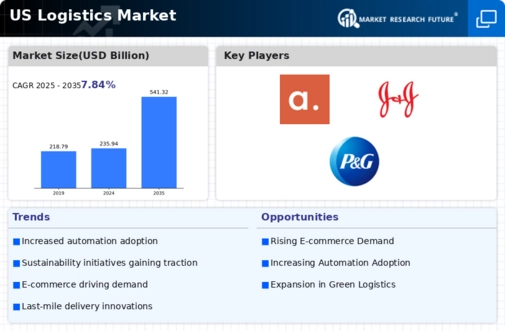The logistics market exhibits a dynamic competitive landscape characterized by rapid technological advancements and evolving consumer demands. Key players such as FedEx (US), UPS (US), and DHL (DE) are at the forefront, each adopting distinct strategies to enhance operational efficiency and customer satisfaction. FedEx (US) emphasizes innovation through its investment in automation and AI, aiming to streamline its delivery processes. Meanwhile, UPS (US) focuses on sustainability initiatives, integrating electric vehicles into its fleet to reduce carbon emissions. DHL (DE) is leveraging digital transformation, enhancing its supply chain visibility through advanced tracking technologies. Collectively, these strategies not only bolster individual company positions but also intensify competition within the market, pushing all players towards greater efficiency and service quality.
The logistics market is moderately fragmented, with a mix of large multinational corporations and regional players. Key business tactics include localizing manufacturing to reduce lead times and optimizing supply chains to enhance responsiveness. The influence of major players is substantial, as their operational strategies often set benchmarks for industry standards. This competitive structure fosters an environment where innovation and adaptability are crucial for survival, compelling companies to continuously refine their approaches to meet market demands.
In October 2025, FedEx (US) announced a partnership with a leading technology firm to develop an AI-driven logistics platform aimed at optimizing route planning and reducing delivery times. This strategic move is significant as it positions FedEx (US) to leverage cutting-edge technology, potentially enhancing its operational efficiency and customer service capabilities. The integration of AI into logistics operations may also serve as a competitive differentiator in an increasingly tech-driven market.
In September 2025, UPS (US) unveiled its ambitious plan to electrify its entire delivery fleet by 2030, committing to a $1 billion investment in sustainable technologies. This initiative underscores UPS's (US) dedication to environmental responsibility and aligns with growing consumer preferences for sustainable practices. By prioritizing sustainability, UPS (US) not only addresses regulatory pressures but also enhances its brand image, appealing to eco-conscious consumers.
In August 2025, DHL (DE) launched a new digital platform designed to enhance supply chain transparency and efficiency for its clients. This platform utilizes blockchain technology to provide real-time tracking and verification of shipments. The strategic importance of this initiative lies in its potential to build trust with customers, as enhanced transparency can lead to improved customer satisfaction and loyalty. As logistics increasingly becomes a service-oriented industry, such innovations are likely to be pivotal in maintaining competitive advantage.
As of November 2025, the logistics market is witnessing a pronounced shift towards digitalization, sustainability, and AI integration. Strategic alliances are becoming increasingly prevalent, as companies recognize the value of collaboration in enhancing service offerings and operational capabilities. The competitive landscape is evolving, with a clear transition from price-based competition to a focus on innovation, technology, and supply chain reliability. This shift suggests that future competitive differentiation will hinge on the ability to adapt to technological advancements and consumer expectations, ultimately redefining success in the logistics market.














Leave a Comment